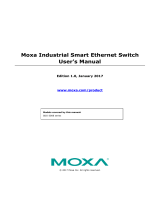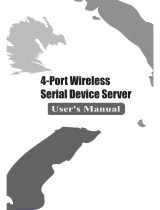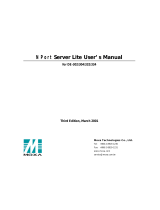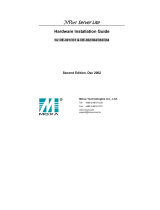Page is loading ...

NPort S8000 Series User’s Manual
Edition 7.0, November 2017
www.moxa.com/product
© 2017 Moxa Inc. All rights reserved.

NPort S8000 Series User’s Manual
The software described in this manual is furnished under a license agreement and may be used only in accordance with
the terms of that agreement.
Copyright Notice
© 2017 Moxa Inc. All rights reserved.
Trademarks
The MOXA logo is a registered trademark of Moxa Inc.
All other trademarks or registered marks in this manual belong to their respective manufacturers.
Disclaimer
Information in this document is subject to change without notice and does not represent a commitment on the part of
Moxa.
Moxa provides this document as is, without warranty of any kind, either expressed or implied, including, but not limited
to, its particular purpose. Moxa reserves the right to make improvements and/or changes to this manual, or to the
products and/or the programs described in this manual, at any time.
Information provided in this manual is intended to be accurate and reliable. However, Moxa assumes no responsibility for
its use, or for any infringements on the rights of third parties that may result from its use.
This product might include unintentional technical or typographical errors. Changes are periodically made to the
information herein to correct such errors, and these changes are incorporated into new editions of the publication.
Technical Support Contact Information
www.moxa.com/support
Moxa
Americas
Toll
-free: 1-888-669-2872
Tel:
+1-714-528-6777
Fax:
+1-714-528-6778
Moxa China (Shanghai office)
Toll
-free: 800-820-5036
Tel:
+86-21-5258-9955
Fax:
+86-21-5258-5505
Moxa Europe
Tel:
+49-89-3 70 03 99-0
Fax: +49-89-3 70 03 99-99
Moxa As
ia-Pacific
Tel:
+886-2-8919-1230
Fax: +886-2-8919-1231
Moxa India
Tel:
+91-80-4172-9088
Fax:
+91-80-4132-1045

Table of Contents
1. Introduction ...................................................................................................................................... 1-1
Overview ........................................................................................................................................... 1-2
Industrial Communications and Automation .................................................................................... 1-2
Industrial vs. Commercial ............................................................................................................. 1-2
Informative vs. Passive ................................................................................................................ 1-2
Package Checklist ............................................................................................................................... 1-2
Product Features ................................................................................................................................ 1-3
2. Getting Started.................................................................................................................................. 2-1
Panel Layout ...................................................................................................................................... 2-2
Dimensions ........................................................................................................................................ 2-3
NPort S8455 Series ..................................................................................................................... 2-3
NPort S8458 Series ..................................................................................................................... 2-4
Connecting the Hardware..................................................................................................................... 2-4
Wiring Requirements ................................................................................................................... 2-5
Connecting the Power .................................................................................................................. 2-5
Connecting to the Network ........................................................................................................... 2-6
Connecting to a Serial Device ....................................................................................................... 2-6
LED Indicators ............................................................................................................................ 2-6
Adjustable Pull High/low Resistors and Terminators for the RS-485 Port (NPort S8455I Series only) ...... 2-6
Wiring the Relay Contact .............................................................................................................. 2-7
Wiring the Digital Inputs .............................................................................................................. 2-8
3. Initial IP Address Configuration ........................................................................................................ 3-1
Static and Dynamic IP Addresses .......................................................................................................... 3-2
Factory Default IP Address ................................................................................................................... 3-2
Configuration Options .......................................................................................................................... 3-2
Device Search Utility .................................................................................................................... 3-2
Web Console ............................................................................................................................... 3-2
ARP ........................................................................................................................................... 3-2
SSH Console ............................................................................................................................... 3-3
Serial Console ............................................................................................................................. 3-7
4. Choosing the Serial Operation Mode ................................................................................................. 4-1
Overview ........................................................................................................................................... 4-2
Real COM Mode .................................................................................................................................. 4-2
RFC2217 Mode ................................................................................................................................... 4-3
TCP Server Mode ................................................................................................................................ 4-3
TCP Client Mode ................................................................................................................................. 4-3
UDP Mode .......................................................................................................................................... 4-4
Disabled Mode .................................................................................................................................... 4-4
5. Use Real COM Mode to Communicate with Serial Devices .................................................................. 5-1
Overview ........................................................................................................................................... 5-2
Device Search Utility ........................................................................................................................... 5-2
Installing the Device Search Utility ................................................................................................ 5-2
Find a Specific NPort on the Ethernet Network via the DSU ............................................................... 5-5
Opening Your Browser ................................................................................................................. 5-6
Configure Operation Mode to Real COM Mode.................................................................................. 5-8
NPort Windows Driver Manager ............................................................................................................ 5-9
Installing the NPort Windows Driver Manager .................................................................................. 5-9
Using NPort Windows Driver Manager .......................................................................................... 5-12
Linux Real TTY Drivers ...................................................................................................................... 5-19
Basic Procedures ....................................................................................................................... 5-19
Hardware Setup ........................................................................................................................ 5-20
Installing Linux Real TTY Driver Files ........................................................................................... 5-20
Mapping TTY Ports ..................................................................................................................... 5-20
Removing Mapped TTY Ports ....................................................................................................... 5-21
Removing Linux Driver Files ........................................................................................................ 5-21
The UNIX Fixed TTY Driver ................................................................................................................. 5-21
Installing the UNIX Driver........................................................................................................... 5-21
Configuring the UNIX Driver ....................................................................................................... 5-22
6. Basic Settings and Device Server Configuration ................................................................................ 6-1
Basic Settings .................................................................................................................................... 6-2
General Settings ......................................................................................................................... 6-2
Time Settings ............................................................................................................................. 6-3
Network Settings ......................................................................................................................... 6-4
Serial Settings .................................................................................................................................... 6-7
Operation Modes ......................................................................................................................... 6-7
Serial Parameters ...................................................................................................................... 6-22

Serial ToS Settings .................................................................................................................... 6-24
7. Switch Featured Functions ................................................................................................................ 7-1
Ethernet Settings ................................................................................................................................ 7-2
Port Settings ............................................................................................................................... 7-2
Port Trunking .............................................................................................................................. 7-3
Communication Redundancy ......................................................................................................... 7-5
STP/RSTP ........................................................................................................................................ 7-15
The STP/RSTP Concept .............................................................................................................. 7-15
Configuring STP/RSTP ................................................................................................................ 7-19
Configuration Limits of STP/RSTP ................................................................................................ 7-20
Bandwidth Management .................................................................................................................... 7-21
Using Bandwidth Management .................................................................................................... 7-21
Configuring Bandwidth Management ............................................................................................ 7-21
Line Swap Fast Recovery ................................................................................................................... 7-21
Using Line-Swap-Fast-Recovery .................................................................................................. 7-21
Configuring Line-Swap Fast Recovery .......................................................................................... 7-22
Ethernet Advanced Settings ............................................................................................................... 7-22
Ethernet Traffic Prioritization ...................................................................................................... 7-22
The Traffic Prioritization Concept ................................................................................................. 7-23
Configuring Ethernet Traffic Prioritization ..................................................................................... 7-24
Virtual LAN ...................................................................................................................................... 7-27
Using Virtual LAN ...................................................................................................................... 7-27
The Virtual LAN (VLAN) Concept .................................................................................................. 7-27
Configuring Virtual LAN .............................................................................................................. 7-31
Multicast Filtering ............................................................................................................................. 7-33
Using Multicast Filtering ............................................................................................................. 7-33
The Concept of Multicast Filtering ................................................................................................ 7-33
Configuring IGMP Snooping ........................................................................................................ 7-35
IGMP Snooping Settings ............................................................................................................. 7-36
Configuring GMRP...................................................................................................................... 7-38
Set Device IP ................................................................................................................................... 7-38
Using Set Device IP ................................................................................................................... 7-38
Configuring Set Device IP ........................................................................................................... 7-39
System Management ......................................................................................................................... 7-40
Misc. Network Settings ............................................................................................................... 7-40
SysLog Server .................................................................................................................................. 7-41
Using Syslog ............................................................................................................................. 7-41
Local User Database .................................................................................................................. 7-43
Port Access Control ........................................................................................................................... 7-43
Configuring Static Port Lock ........................................................................................................ 7-45
Configuring IEEE 802.1X ............................................................................................................ 7-46
Auto Warning Settings ............................................................................................................... 7-47
Configuring E-Mail Alert ..................................................................................................................... 7-47
Configuring SNMP ............................................................................................................................. 7-49
SNMP Read/Write Settings .......................................................................................................... 7-50
E-mail Event Settings ................................................................................................................ 7-51
SNMP Trap ............................................................................................................................... 7-53
Relay Alarm Settings ................................................................................................................. 7-54
System Log Settings .................................................................................................................. 7-55
Maintenance .................................................................................................................................... 7-57
Console Settings ....................................................................................................................... 7-57
Ping ......................................................................................................................................... 7-57
Update System Files from Local PC .............................................................................................. 7-58
Load Factory Default .................................................................................................................. 7-60
Change Password ...................................................................................................................... 7-61
Mirror Port Settings ................................................................................................................... 7-61
TFTP Settings............................................................................................................................ 7-62
DIP Switch Settings ................................................................................................................... 7-63
System Monitoring ............................................................................................................................ 7-65
Serial Status ............................................................................................................................. 7-65
System Status .......................................................................................................................... 7-67
Ethernet Status ......................................................................................................................... 7-68
Restart ............................................................................................................................................ 7-73
Restart System ......................................................................................................................... 7-73
Restart Serial Port ..................................................................................................................... 7-74
A. Pinouts and Cable Wiring .................................................................................................................. A-1
Port Pinout Diagrams .......................................................................................................................... A-2
Ethernet Port Pinouts ................................................................................................................... A-2
Serial Port Pinouts ....................................................................................................................... A-2
Cable Wiring Diagrams ........................................................................................................................ A-3
Ethernet Cables........................................................................................................................... A-3

B. Well-Known Port Numbers ................................................................................................................ B-1
C. SNMP Agents with MIB II & RS-232 Like Groups .............................................................................. C-1
D. Switch MIB Groups ............................................................................................................................ D-1
E. Compliance Note ............................................................................................................................... E-1

1
1. Introduction
The Moxa NPort S8000 is an advanced industrial serial device server integrated with a fully managed redundant
Ethernet switch, which enables easy network operation for your serial devices and connects Ethernet-enabled
devices in industrial field applications.
The NPort S8000 Series includes seven models:
• NPort S8455I
Combination switch / device server with 4 RS-232/422/485 ports, 5 10/100M Ethernet ports, RJ45
connector, 12–48 VDC, 0 to 60°C operating temperature
• NPort S8455I-T
Combination switch / device server with 4 RS-232/422/485 ports, 5 10/100M Ethernet ports, RJ45
connector, 12–48 VDC, -40 to 75°C operating temperature
• NPort S8455I-MM-SC
Combination switch / device server with 4 RS-232/422/485 ports, 3 10/100M Ethernet ports, 2 100M
multimode fiber ports, SC connector, 12–48 VDC, 0 to 60°C operating temperature
• NPort S8455I-MM-SC-T
Combination switch / device server with 4 RS-232/422/485 ports, 3 10/100M Ethernet ports, 2 100M
multimode fiber ports, SC connector, 12–48 VDC, -40 to 75°C operating temperature
• NPort S8455I-SS-SC
Combination switch / device server with 4 RS-232/422/485 ports, 3 10/100M Ethernet ports, 2 100M
single-mode fiber ports, SC connector, 12–48 VDC, 0 to 60°C operating temperature
• NPort S8455I-SS-SC-T
Combination switch / device server with 4 RS-232/422/485 ports, 3 10/100M Ethernet ports, 2 100M
single-mode fiber ports, SC connector, 12–48 VDC, -40 to 75°C operating temperature
• NPort S8458-4S-SC-T
4 RS-232/422/485 ports, 4 10/100M Ethernet ports, 4 100M single-mode fiber ports with SC connector,
combo switch serial device server, 12-48 VDC, -40 to 85°C operating temperature
The following topics are covered in this chapter:
Overview
Industrial Communications and Automation
Industrial vs. Commercial
Informative vs. Passive
Package Checklist
Product Features

NPort S8000 Series Introduction
1-2
Overview
The NPort S8000 is an industrial device server that integrates a managed Ethernet switch with a fully functional
serial device server. The NPort S8000 device servers are designed to make your industrial serial devices
instantly Internet-ready.
The NPort S8458 offers four fiber Ethernet ports, four Ethernet ports, and four RS-232/422/485 serial ports in
a single device. Its design not only saves cabinet space and reduces power consumption, but also saves money
since you don’t need to purchase separate switches and serial device servers.
The compact size of the NPort S8000 device servers makes them the ideal choice for connecting
RS-232/422/485 serial devices, such as PLCs, meters, and sensors, to an IP-based Ethernet LAN, making it
possible for your software to access serial devices anywhere over a LAN or the Internet.
The NPort S8000 is a fully equipped managed Ethernet Switch with a suite of useful maintenance and
monitoring functions, and it is designed to provide smooth and reliable operation in harsh industrial
environments. It is ideal for keeping automation systems running continuously, sending status reports to help
prevent system damage and losses, and managing your industrial Ethernet networks and serial devices.
Industrial Communications and Automation
As the world’s networking and information technology becomes more complex, Ethernet has become the major
communications interface in many industrial communications and automation applications. In fact, a whole
new industry has sprung up to provide Ethernet products that comply with the requirements of demanding
industrial applications.
Industrial vs. Commercial
Users have found that when transplanting Ethernet from comfortable office environments to harsh and less
predictable industrial environments, commercial Ethernet equipment available in today’s market simply cannot
meet the high-reliability requirements demanded by industrial applications. This means that more robust
networking equipment, commonly referred to as industrial Ethernet equipment, is required for these
applications.
Informative vs. Passive
Since industrial Ethernet devices are often located at the endpoints of a system, such devices cannot always
know what’s happening elsewhere on the network. This means that industrial Ethernet communication
equipment that connects these devices must provide system administrators with real-time alarm messages.
Package Checklist
The Moxa NPort S8000 Series products are shipped with the following items:
Standard Accessories
• 1 NPort S8000 serial device server
• NPort Document & Software CD
• NPort S8000 Series Quick Installation Guide
• Product warranty statement
• RJ45-to-DB9 console port cable
Optional Accessories
• Wall-mounting kit
NOTE: Notify your sales representative if any of the above items is missing or damaged.

NPort S8000 Series Introduction
1-3
Product Features
The NPort S8000 Series products enjoy the following features:
• Make your serial devices Internet ready
• Versatile socket operation modes, including TCP Server, TCP Client, and UDP
• Easy-to-use Windows Utility for mass installation
• Supports 10/100 Mbps Ethernet—auto detectable
• Supports SNMP MIB-II for network management
• Configuration auto-restore by LLDP (Link Layer Discovery Protocol)
• Configurable serial data transmission priority
• Multiport managed Ethernet switch
• Ethernet redundancy by Turbo Ring (recovery time < 20 ms), RSTP/STP (IEEE 802.1w/D)
• QoS, IGMP snooping/GMRP, VLAN, LACP, SNMPv1/v2c/v3, RMON supported
• 4 serial ports device server, support RS-232/422/RS-485
• 2k VDC isolation protection for serial port (the NPort S8455I Series only)
• Surge protection for serial/power/Ethernet
• Adjustable pull high/low resistor and terminators for the RS-485 port (the NPort S8455I Series only)
• 2- or 4-wire RS-485 with patented ADDC™ (Automatic Data Direction Control)

2
2. Getting Started
This chapter details the installation of the NPort S8000 series device servers. Note that the manual uses the
NPort S8455 Series as an example to illustrate the functionality of the NPort S8000 Series in chapters 2, 3, 4,
6 and 7.
The following topics are covered in this chapter:
Panel Layout
Dimensions
NPort S8455 Series
NPort S8458 Series
Connecting the Hardware
Wiring Requirements
Connecting the Power
Connecting to the Network
Connecting to a Serial Device
LED Indicators
Adjustable Pull High/low Resistors and Terminators for the RS-485 Port (NPort S8455I Series only)
Wiring the Relay Contact
Wiring the Digital Inputs

NPort S8000 Series Getting Started
2-2
Panel Layout

NPort S8000 Series Getting Started
2-3
Dimensions
NPort S8455 Series

NPort S8000 Series Getting Started
2-4
NPort S8458 Series
Connecting the Hardware
This section describes how to connect the NPort S8000 to serial devices for initial testing purposes. We cover
Wiring Requirements, Connecting the Power, Grounding the NPort S8000, Connecting to the
Network, Connecting to a Serial Device, and LED Indicators.

NPort S8000 Series Getting Started
2-5
Wiring Requirements
ATTENTION
Safety First!
Be sure to disconnect the power cord before installing and/or wiring your NPort S8000.
Wiring Caution!
Calculate the maximum possible current in each power wire and com
mon wire. Observe all electrical codes
dictating the maximum current allowable for each wire size.
If the current goes above the
allowed maximum
, the wiring could overheat, causing serious damage to your
equipment.
Temperature Caution!
Please take care whe
n handling the NPort S8000. When plugged in, the NPort S8000’s internal components
generate heat; consequently, the casing may be too hot to touch.
You should heed the following:
• Use separate paths to route wiring for power and devices. If power wiring and device wiring paths must
cross, make sure the wires are perpendicular at the intersection point.
NOTE: Do not run signal or communication wiring and power wiring in the same wire conduit. To avoid
interference, wires with different signal characteristics should be routed separately.
• You can use the type of signal transmitted through a wire to determine which wires should be kept separate.
The rule of thumb is that wiring that shares similar electrical characteristics can be bundled together.
• Keep input wiring and output wiring separate.
• Where necessary, it is strongly advised that you label wiring to all devices in the system.
Connecting the Power
Connect the 12-48 VDC power line with the NPort S8000’s terminal block. If the power is properly supplied, the
“Ready” LED will show a solid red color until the system is ready, at which time the “Ready” LED will change to
a green color.
Take the following steps to wire the redundant power inputs:
1. Insert the negative/positive DC wires into the V-/V+ terminals.
2. To keep the DC wires from pulling loose, use a small flat-blade screwdriver to tighten the wire-clamp screws
on the front of the terminal block connector.
3. Insert the plastic terminal block connector prongs into the terminal block receptor, which is located on the
EDS’s top panel.

NPort S8000 Series Getting Started
2-6
Connecting to the Network
Connect one end of the Ethernet cable to the NPort S8000’s 10/100M Ethernet port and the other end of the
cable to the Ethernet network. If the cable is properly connected, the NPort S8000 will indicate a valid
connection to the Ethernet in the following ways:
• The Ethernet LED maintains a solid green color when connected to a 100 Mbps Ethernet network.
• The Ethernet LED will flash when Ethernet packets are being transmitted or received.
Connecting to a Serial Device
Connect the serial data cable between the NPort S8000 and the serial device.
LED Indicators
The LED indicators of the NPort S8000 Series are described in the following table.
Type Color Meaning
PWR 1 Green Power 1 input
PWR 2 Green Power 2 input
LINK (FX)
Green FX port 100 Mbps is active
Blinking Data is being transmitted/received at 100 Mbps
LINK
Green 100 Mbps Ethernet connection
Blinking 10 Mbps Ethernet connection
Master
Green When the NPort is the Master of this Turbo Ring
Yellow
When the NPort is the Ring Master of this Turbo Ring and the Turbo Ring
is broken
Coupler Green When the NPort enables the coupling function to form a backup path
Serial Port TX Green The serial port is transmitting data.
Serial Port RX
Yellow
The serial port is receiving data.
Ready
Red
Steady On: Power is on, and NPort is booting up.
Blinking: Indicates an LAN-
IP conflict, or the DHCP or BOOTP server did
not respond properly.
Green
Steady On: Power is on, and NPort is functioning normally.
Blinking: The device server has been located by Administrator’s Location
function.
Off Power is off, or power error condition exists.
Adjustable Pull High/low Resistors and Terminators for the
RS-485 Port (NPort S8455I Series only)
In some critical environments, you may need to add termination resistors to prevent the reflection of serial
signals. When using termination resistors, it is important to set the pull high/low resistors correctly so that the
electrical signal is not corrupted. Since there is no resistor value that works for every environment, DIP
switches are used to set the pull high/low resistor values for each RS-485 port.
To set the pull high/low resistors to 150 KΩ, make sure both of the assigned DIP switches are in the OFF
position. This is the default setting.
To set the pull high/low resistors to 1 KΩ, make sure both of the assigned DIP switches are in the ON
position.

NPort S8000 Series Getting Started
2-7
SW
1 2 3 4 3 & 4
Pull High Pull Low Terminator Terminator Terminator
ON 1 KΩ 1 KΩ 120 Ω 100 Ω 55 Ω
Default
OFF 150 KΩ 150 KΩ – – –
ATTENTION
Do
not set the resistors to 1 KΩ. When using RS-232. Doing so will degrade the RS-232 signals and reduce
the
effective communication distance.
Wiring the Relay Contact
The NPort 8455I Series has two sets of relay output: relay 1 and relay 2. Each relay contact consists of two
contacts of the terminal block on the NPort 8455I’s top panel. Refer to the next section for detailed instructions
on how to connect the wires to the terminal block connector and how to attach the terminal block connector to
the terminal block receptor. The two contacts used to connect the relay contacts work as follow (illustrated
below):
The fault circuit will open if
1.
A relay warning event is triggered,
OR
2.
The NPort S8000 is the Master of this Turbo Ring,
and the
Turbo Ring is broken,
OR
3.
Start-up failure.
If none of these three conditions
are
met, the fault circuit will
remain
closed.

NPort S8000 Series Getting Started
2-8
Wiring the Digital Inputs
The NPort 8455I unit has two sets of digital inputs, DI 1 and DI 2. Each DI consists of two contacts of the 6-pin
terminal block connector on the NPort 8455I’s top panel. The remaining contacts are used for the NPort 8455I’s
two DC inputs. The top and front views of one of the terminal block connectors are shown below.
Take the following steps to wire the digital inputs:
1.
Insert the negative (ground)/positive DI wires into the ┴/I1
terminals.
2.
To keep the DI wires from pulling loose, use a small flat-
blade
screwdriver to tighten the wire-
clamp screws on the front of the
terminal block connector.
3.
Insert the plastic terminal block connector prongs into the
terminal block receptor, which is located on the NPort 8455I’s
top panel.

3
3. Initial IP Address Configuration
When setting up the NPort S8000 for the first time, the first thing you should do is configure its IP address. This
chapter introduces the different methods that can be used.
The following topics are covered in this chapter:
Static and Dynamic IP Addresses
Factory Default IP Address
Configuration Options
Device Search Utility
Web Console
ARP
SSH Console
Serial Console

NPort S8000 Series Initial IP Address Configuration
3-2
Static and Dynamic IP Addresses
Determine whether your NPort S8000 needs to use a static IP or dynamic IP address (either DHCP or BOOTP
application).
• If your NPort S8000 is used in a static IP environment, you will assign a specific IP address using one
of the tools described in this chapter.
• If your NPort S8000 is used in a dynamic IP environment, the IP address will be assigned
automatically over the network. In this case, set the IP configuration mode to DHCP, BOOTP.
ATTENTION
Consult your network administrator on how to reserve a
fixed IP address for your NPort S8000 in the MAC-
IP
mapping table when using a DHCP server or BOOTP server. For most applications, you should assign a fixed IP
address to your NPort S8000.
Factory Default IP Address
The NPort S8000 is configured with the following default private IP address:
192.168.127.254
Note that IP addresses that begin with “192.168” are referred to as private IP addresses. Devices configured
with a private IP address are not directly accessible from a public network. For example, you would not be able
to ping a device with a private IP address from an outside Internet connection. If your application requires
sending data over a public network, such as the Internet, your NPort S8000 will need a valid public IP address,
which can be leased from a local ISP.
Configuration Options
Device Search Utility
You may configure your NPort S8000 with the bundled Device Search Utility (DSU) for Windows platform. Note
that you will be asked to enter the username and password to access the NPort S8000 device. The default
username is admin and the default password is moxa. Please refer to Chapter 5, “Use Real COM Mode to
Communicate with Serial Devices”, for details on how to install and use the DSU.
Web Console
You may configure your NPort S8000 using a standard web browser. Note that you will be asked to enter the
username and password to access the NPort S8000 device. The default username is admin and the default
password is moxa. Please refer to Chapter 6, “Basic Settings and Device Server Configuration”, for details on
how to access and use the NPort S8000 web console.
ARP
You may use the Address Resolution Protocol (ARP) command to set up an IP address for your NPort S8000.
The ARP command tells your computer to associate the NPort S8000’s MAC address with an IP address.
Afterwards, use Telnet to access the NPort S8000 and its IP address will be reconfigured.

NPort S8000 Series Initial IP Address Configuration
3-3
ATTENTION
In order to use the ARP setup method, both your computer and
the NPort S8000 must be connected to the
same LAN. Alternatively, you may use a crossover Ethernet cable to connect the NPort S8000 directly to your
computer’s Ethernet card. Before executing the ARP command, your NPort S8000 must be configured with the
factory default IP address (192.168.127.254), and your computer and the NPort S8000 must be on the same
subnet.
To use ARP to configure the IP address, complete the following:
1. Obtain a valid IP address for your NPort S8000 from your network administrator.
2. Obtain your NPort S8000’s MAC address from the label on the bottom panel.
3. Execute the arp -s command from your computer’s MS-DOS prompt (for Windows 7 or newer OS, please
ensure you have the administrator authority to execute the MS-DOS prompt) as follows:
arp -s <IP address> <MAC address>
For example,
C:\> arp -s 192.168.200.100 00-90-E8-04-00-11
4. Next, execute a special Telnet command by entering the following exactly:
telnet 192.168.200.100 6000
When you enter this command, a Connect failed message will appear, as shown below.
5. After the NPort S8000 reboots, its IP address will be assigned to the new address, and you can reconnect
using Telnet to verify that the update was successful.
SSH Console
Depending on how your computer and network are configured, you may find it convenient to use network
access to set up your NPort S8000’s IP address. This can be done using Telnet/SSH. The instructions below will
be introduced by using SSH, which offers security mechanisms that protect users against any malicious
behavior.
1. It's easy to find SSH client software on the Internet. Please download, install, and execute it and input the
destination NPort's IP and the TCP port to accept the SSH session.

NPort S8000 Series Initial IP Address Configuration
3-4
2. The console terminal type selection is displayed as shown. Enter the username and password to log in to the
SSH console. The default username and password are admin and moxa, respectively.
3. Enter 1 for ansi/vt100 and press ENTER to continue.
/






